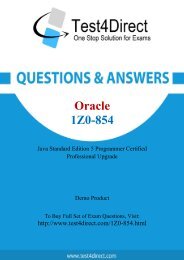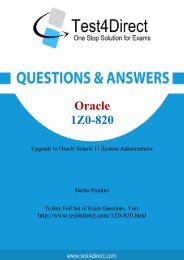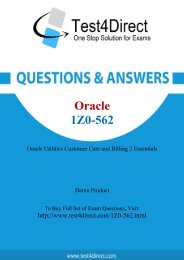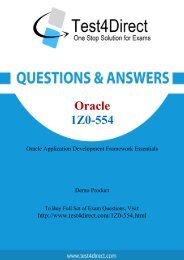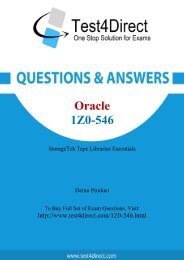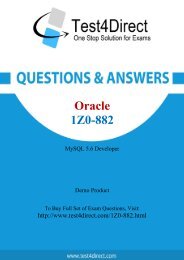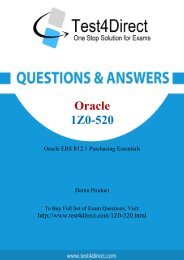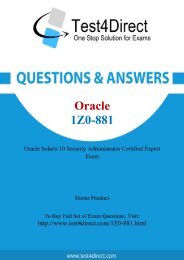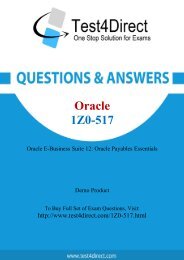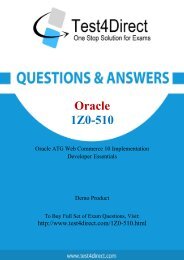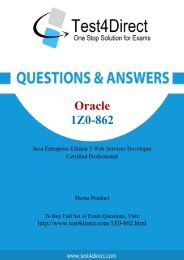Up-to-Date 1Z0-574 Exam BrainDumps
Test4Direct provides latest PDF questions of Oracle 1Z0-574 exam. You have an opportunity to pass the Oracle 1Z0-574 exam in one go. Test4Direct is most accurate source to prepare Oracle 1Z0-574 exam as your success will become site’s responsibility after purchasing 1Z0-574 exam product. There are also lots of discounts and promotion offers that you can avail. Let’s try a free demo http://www.test4direct.com/1Z0-574.html
Test4Direct provides latest PDF questions of Oracle 1Z0-574 exam. You have an opportunity to pass the Oracle 1Z0-574 exam in one go. Test4Direct is most accurate source to prepare Oracle 1Z0-574 exam as your success will become site’s responsibility after purchasing 1Z0-574 exam product. There are also lots of discounts and promotion offers that you can avail. Let’s try a free demo http://www.test4direct.com/1Z0-574.html
You also want an ePaper? Increase the reach of your titles
YUMPU automatically turns print PDFs into web optimized ePapers that Google loves.
Oracle<br />
<strong>1Z0</strong>-<strong>574</strong><br />
Oracle IT Architecture Release 3 Essentials<br />
Demo Product<br />
To Buy Full Set of <strong>Exam</strong> Questions, Visit:<br />
http://www.test4direct.com/<strong>1Z0</strong>-<strong>574</strong>.html
Question: 1<br />
Which of the following are ORA Engineering logical categories?<br />
A. Integrated Development Environment<br />
B. Quality Manager<br />
C. Asset Manager<br />
D. Moni<strong>to</strong>ring and Management<br />
Question: 2<br />
Question: 3<br />
Answer: A,B<br />
Explanation:<br />
The Engineering logical view shows the logical components of the Engineering environment and<br />
show how they are connected <strong>to</strong> each other. T<br />
The primary logical categories as shown are:<br />
*Modeler<br />
*Integrated Development Environment (IDE)<br />
*Quality Manager<br />
*Deployment Manager<br />
*Metadata Reposi<strong>to</strong>ry<br />
*Asset Reposi<strong>to</strong>ry<br />
Reference:<br />
Oracle Reference Architecture, Software Engineering, Release 3.0, Engineering Logical View<br />
Which of the following options best describes the concept of data-driven testing?<br />
A. Data-driven testing is a strategy used <strong>to</strong> perform load testing.<br />
B. Data-driven testing is used <strong>to</strong> perform functional tests by iterating through data sets in a databank.<br />
C. Data-driven testing uses a single predefined data set <strong>to</strong> perform repeated testing.<br />
D. Data-driven testing uses database triggers <strong>to</strong> initiate and run test cases.<br />
Answer: B<br />
Explanation:<br />
One of the best ways <strong>to</strong> perform functional testing is through data-driven testing, in which a<br />
databank is created <strong>to</strong> cover the various functional use cases and is used <strong>to</strong> drive the testing. This<br />
requires the ability <strong>to</strong> iterate through a list of data sets in the databank, substitute them for the input<br />
values, and run the tests. Reference: Oracle Reference Architecture, Software Engineering, Release<br />
3.0, Data driven testing<br />
As part of a company-wide IT Initiative <strong>to</strong> simplify and rationalize the technology and products used<br />
you have been tasked with defining an Enterprise Architecture. The Enterprise Architecture will be
used <strong>to</strong> communicate the desired future state where redundant, deprecated, and undesired<br />
technology and products have been eliminated. Oracle products will be included. In the Enterprise<br />
Architecture, it will be products from other vendors, including products that directly compete with<br />
Oracle products. Which option best describes how IT Strategies from Oracle (ITSO) material can be<br />
used while creating the Enterprise Architecture?<br />
A. The ITSO material cannot be used because ITSO applies <strong>to</strong> Oracle products only.<br />
B. The ITSO material can be used without modification because it has no Oracle product<br />
dependencies.<br />
C. The ITSO material can be used as reference material but will require cus<strong>to</strong>mization <strong>to</strong> reflect<br />
specific products selected by the company.<br />
D. The Oracle Reference Architecture component of ITSO can be readily applied, but the Rest of ITSO<br />
cannot, because of product dependencies.<br />
E. The Oracle Reference Architecture component of ITSO cannot be applied due <strong>to</strong> pre dependencies,<br />
but the rest of ITSO can be applied.<br />
F. The ITSO material is not applicable <strong>to</strong> rationalization of IT asset<br />
Question: 4<br />
Answer: C<br />
Explanation:<br />
IT Strategies from Oracle (ITSO) is a series of documentation and supporting collateral designed <strong>to</strong><br />
enable organizations <strong>to</strong> develop an architecture-centric approach <strong>to</strong> enterprise-class IT initiatives.<br />
ITSO presents successful technology strategies and solution designs by defining universally adopted<br />
architecture concepts, principles, guidelines, standards, and patterns.<br />
ITSO is made up of three primary elements:<br />
* Oracle Reference Architecture (ORA) defines a detailed and consistent architecture for developing<br />
and integrating solutions based on Oracle technologies. The reference architecture offers<br />
architecture principles and guidance based on recommendations from technical experts across<br />
Oracle. It covers a broad spectrum of concerns pertaining <strong>to</strong> technology architecture, including<br />
middleware, database, hardware, processes, and services. * Enterprise Technology Strategies (ETS)<br />
offer valuable guidance on the adoption of horizontal technologies for the enterprise.They explain<br />
how <strong>to</strong> successfully execute on a strategy by addressing concerns pertaining <strong>to</strong> architecture,<br />
technology, engineering, strategy, and governance. An organization can use this material <strong>to</strong> measure<br />
their maturity, develop their strategy, and achieve greater levels of success and adoption. In<br />
addition, each ETS extends the Oracle Reference Architecture by adding the unique capabilities and<br />
components provided by that particular technology. It offers a horizontal technology-based<br />
perspective of ORA.<br />
* Enterprise Solution Designs (ESD) are industry specific solution perspectives based on ORA. They<br />
define the high level business processes and functions, and the software capabilities in an underlying<br />
technology infrastructure that are required <strong>to</strong> build enterprise-wide industry solutions. ESDs also<br />
map the relevant application and technology products against solutions <strong>to</strong> illustrate how capabilities<br />
in Oracle’s complete integrated stack can best meet the business, technical and quality of service<br />
requirements within a particular industry. Reference: IT Strategies from Oracle, An Overview, Release<br />
3.0<br />
The three common goals of Information security are known as the CIA triad. CIA stands for:<br />
A. Confidentiality, Integrity and Auditing<br />
B. Confidentiality, Integrity and Availability
C. Confidentiality, Integrity and Access Control<br />
D. Confidentiality, Integrity and Authentication<br />
E. Confidentiality,Integrity and Authorization<br />
Question: 5<br />
Question: 6<br />
Answer: B<br />
Explanation:<br />
For over twenty years, information security has held confidentiality, integrity and availability (known<br />
as the CIA triad) <strong>to</strong> be the core principles of information security.<br />
There is continuous debate about extending this classic trio.<br />
Note:<br />
Confidentiality is the term used <strong>to</strong> prevent the disclosure of information <strong>to</strong> unauthorized individuals<br />
or systems.<br />
In information security, integrity means that data cannot be modified undetectably.<br />
For any information system <strong>to</strong> serve its purpose, the information must be available when it is<br />
needed.<br />
Which statements best describe how architecture principles are used within the Oracle Reference<br />
Architecture (ORA)?<br />
A. The architecture principles for Oracle products are identified whenever an Oracle product<br />
incorporated in<strong>to</strong> the architecture.<br />
B. ORA uses multiple architecturalviews where each view has its own architecture principles.<br />
C. ORA documents describe the architectural principles upon which the architecture is based.<br />
D. Architecture principles provide recommendations (based on industry best practices) that should<br />
be followed.<br />
E. Architecture principles are rules that must be followedin order <strong>to</strong> comply with the documented<br />
architecture.<br />
Answer: C<br />
Explanation:<br />
The purpose of ORA is <strong>to</strong> provide a reference architecture for designing, building,<br />
and integrating solutions based on modern technology from Oracle and other vendors. The reference<br />
architecture offers architecture principles and guidance based on recommendations from Oracle<br />
product development architects and field experts. Information provided by ORA gives architects an<br />
understanding of how <strong>to</strong> design solutions for the Oracle environment and best leverage its<br />
capabilities.<br />
Note: Oracle Reference Architecture (ORA) defines a detailed and consistent architecture for<br />
developing and integrating solutions based on Oracle technologies. The reference architecture offers<br />
architecture principles and guidance based on recommendations from technical experts across<br />
Oracle. It covers a broad spectrum of concerns pertaining <strong>to</strong> technology architecture, including<br />
middleware, database, hardware, processes, and services.<br />
Reference: IT Strategies from Oracle, An Overview, Release 3.0<br />
Which statement best describes the relationship between a SOA Service and service Infrastructure?
A. Service infrastructure is a primary part of an SOA Service.<br />
B. Service Infrastructure exposes the Service Interface and may satisfy some capabilities of the<br />
Service Implementation.<br />
C. Service infrastructure fulfills the Service Contract.<br />
D. A SOA Service depends on the service infrastructure <strong>to</strong> satisfy some required capabilities.<br />
E. A SOA Service uses the service infrastructure <strong>to</strong> generate the Service Interface.<br />
Question: 7<br />
Question: 8<br />
Answer: B<br />
Explanation:<br />
The Service Infrastructure side typically provides the Service enablement capabilities<br />
for the implementation. These capabilities may include, exposing the interface as a Web Service,<br />
handling SLA enforcement, security, data formatting, and others. Service infrastructure should be<br />
utilized when possible, as it reduces the burden on Service providers, from an implementation<br />
standpoint.<br />
Reference: Oracle Reference Architecture,SOA Foundation, Release 3.1<br />
Which WebCenter product Improves efficiency and productivity by enabling users <strong>to</strong> connect with<br />
others, regardless of their location, via web and voice conferencing, instant messaging, presence,<br />
and chat rooms?<br />
A. Oracle WebCenter Intelligent Collaboration<br />
B. Oracle WebCenter Anywhere<br />
C. Oracle WebCenter Real-Time Collaboration<br />
D. Oracle WebCenter Spaces<br />
Answer: C<br />
Explanation:<br />
Oracle WebCenter Real-Time Collaboration improves efficiency and productivity by enabling users <strong>to</strong><br />
connect and collaborate with others via instant messaging, presence, chat rooms, and web and voice<br />
conferencing. It complements other Enterprise 2.0 services available in Oracle WebCenter by offering<br />
real-time collaboration capabilities <strong>to</strong> users who require direct interaction and immediate response.<br />
Bot<strong>to</strong>m-up service Identification analyzes existing systems <strong>to</strong> Identify SOA Services. Top-down service<br />
identification analyzes business processes <strong>to</strong> identify SOA services. Which statement best describes<br />
the relationship between <strong>to</strong>p down and bot<strong>to</strong>m-up service identification in Service-Oriented<br />
Integration?<br />
A. Only a bot<strong>to</strong>m up approach should be used because the goal of SOI is <strong>to</strong> provide SOA Services<br />
exposing existing systems.<br />
B. Only a <strong>to</strong>p-down approach should be used because the goal of SOI is composite application<br />
assembly.<br />
C. A bot<strong>to</strong>m-up approach should be used <strong>to</strong> identify which SOA Services are built; then a <strong>to</strong>p down<br />
approach should be used <strong>to</strong> determine which SOA Services are used by each composite application.
D. A <strong>to</strong>p-down approach should be used <strong>to</strong> determine the needed SOA Services; then a bot<strong>to</strong>m-up<br />
approach should be used <strong>to</strong> determine how existing source systems can meet the requirements <strong>to</strong>pdown<br />
approach should be used by business, and a bot<strong>to</strong>m-up approach should be used by IT. The<br />
overlaps between the SOA Services Identified by the two methods are the ones that should<br />
Question: 9<br />
Answer: D<br />
Explanation:<br />
Note: There are three schools of thought around "how <strong>to</strong> build an Enterprise Service Oriented<br />
Architecture." They are:<br />
* Top down - central group decides everything and the dev teams adopt them.<br />
* Bot<strong>to</strong>m up - central group provides a direc<strong>to</strong>ry and dev teams make whatever services they want.<br />
Dev teams go <strong>to</strong> the direc<strong>to</strong>ry <strong>to</strong> find services they can use.<br />
* Middle out - central group provides key elements of the interface, including numbering schemes,<br />
message exchange patterns, standard communication mechanisms, and moni<strong>to</strong>ring infrastructure,<br />
and encourages the dev teams <strong>to</strong> use it <strong>to</strong> build services that can be shared.<br />
Which of the following are the key drivers for Grid computing?<br />
A. Improved server utilization - Grid computing allows companies <strong>to</strong> lower costs through the efficient<br />
use of resources.<br />
B. Better agility and flexibility - Businesses experience constant change and the underlying IT<br />
Infrastructure should be agile enough <strong>to</strong> support that kind of change.<br />
C. OpEx model - Enterprises require pay-as-you-go services <strong>to</strong> reduce the dependency on capital<br />
expenditure and take advantage of the benefits of operational expenditure.<br />
D. Lower Initial cost-There is a need <strong>to</strong> reduce the Initial investment at the cost of an increased<br />
operational cost.<br />
Answer: A,B,D<br />
Explanation:<br />
Using a grid computing architecture, organizations can quickly and easily create a large-scale<br />
computing infrastructure from inexpensive, off-the-shelf components (D). Other benefits of grid<br />
computing include<br />
* Quick response <strong>to</strong> volatile business needs (B)<br />
* Real-time responsiveness <strong>to</strong> dynamic workloads<br />
* Predictable IT service levels<br />
* Reduced costs as a result of improved efficiency and smarter capacity planning (A)<br />
Note: One way <strong>to</strong> think about grid computing is as the virtualization and pooling of IT resources—<br />
compute power, s<strong>to</strong>rage, network capacity, and so on—in<strong>to</strong> a single set of shared services thatcan be<br />
provisioned or distributed, andthen redistributed as needed.<br />
As workloads fluctuate during the course of a month, week, or even through a single day, the grid<br />
computing infrastructure analyzes the demand for resources in real time and adjusts the supply<br />
accordingly.<br />
Grid computing operates on three basic technology principles: Standardize hardware and software<br />
components <strong>to</strong> reduce incompatibility and simplify configuration and deployment; virtualize IT<br />
resources by pooling hardware and software in<strong>to</strong> shared resources; and au<strong>to</strong>mate systems<br />
management, including resource provisioning and moni<strong>to</strong>ring.
Grid computing operates on these technology principles:<br />
* Standardization.<br />
* Virtualization.<br />
* Au<strong>to</strong>mation.<br />
Reference: Oracle Grid Computing, White Paper<br />
Question: 10<br />
Which of the following statements are true about an end-<strong>to</strong>-end security strategy?<br />
A. End-<strong>to</strong>-end security and point-<strong>to</strong>-point security are virtually identical strategies proposed by<br />
different security vendors.<br />
B. End-<strong>to</strong>-end security strives <strong>to</strong> protect data at rest, even in temporary queues.<br />
C. End-<strong>to</strong>-end security often involves some form of message-level protection.<br />
D. When end-<strong>to</strong>-end security is enabled. Point-<strong>to</strong>-point transport-level encryption should be disabled<br />
in order <strong>to</strong> avoid cryp<strong>to</strong>graphy conflicts between layers.<br />
E. End <strong>to</strong>-end security is highly beneficial for distributed computing environments where many pointpoint<br />
connections and intermediaries exist, because it offers seamless data protection.<br />
Question: 11<br />
Answer: B,C,E<br />
Explanation:<br />
B:End <strong>to</strong> end security is an information-centric perspective of security where information is<br />
protected throughout the entire computing environment. That is, from<br />
the points where system interactions originate, through all points of integration, processing, and<br />
persistence.<br />
End <strong>to</strong> end security is often associated with the secure transmission, processing, and s<strong>to</strong>rage of data,<br />
where at no time are data unprotected<br />
Note:<br />
For a typical web-based application, end <strong>to</strong> end security generally begins at the client/browser, and<br />
ends at the application database and all external dependencies of the application.<br />
A common challenge in providing end <strong>to</strong> end security is finding a suitable way <strong>to</strong> secure data in all<br />
states and points along the processing path that does not interfere with any transmission, routing,<br />
processing, and s<strong>to</strong>rage functions that need <strong>to</strong> occur along the way. Sensitive data will usually need<br />
<strong>to</strong> be decrypted at certain points in order for processing or message routing <strong>to</strong> occur.<br />
Conceptually, the ORA model of a "modern UI" defines which three layers from the following list?<br />
A. Unified User Interface layer provides the control and visual elements that define the interaction<br />
that the user has with the system.<br />
B. Integration layer provides connec<strong>to</strong>rs <strong>to</strong> simplify and standardize Interaction with back-end -terns.<br />
C. Device Management layer provides transformation and transcoding <strong>to</strong> support a wide variety of<br />
devices.<br />
D. Browser Mediation layer adapts output <strong>to</strong> conform <strong>to</strong> the standards and capabilities of each<br />
browser type.<br />
E. User Interface Services layer provides reusable functions specialized <strong>to</strong> the needs of the end<br />
F. Access and Incorporation layer provides the capability <strong>to</strong> Incorporate data and functionality from<br />
any number of back-end systems in<strong>to</strong> the user interface.
Answer: A,E,F<br />
Explanation:<br />
Note:<br />
A: The Unified User Interface layer provides the control and visual elements that define the<br />
interaction the user has with the system. This layer separates the way the user interacts with the<br />
system from the underlying functionality provided by the system.<br />
This has many advantages including allowing different display devices <strong>to</strong> be supported via control<br />
and visual elements specialized for the device since, for example, mobile devices do not have nearly<br />
the screen real estate of a desk<strong>to</strong>p computer.<br />
E: The User Interface Services layer provides a set of functionality that can be used and reused in a<br />
variety of ways <strong>to</strong> deliver various user interfaces specialized <strong>to</strong> the needs of the end user. This<br />
illustrates that the underlying functionality is separated from the visual and control elements built<br />
in<strong>to</strong> the user interface. The services provided by this layer may come from a variety of sources<br />
located anywhere that is network accessible.<br />
F: The Access and Incorporation layer provides the capability <strong>to</strong> incorporate data and functionality<br />
from any number of backend systems in<strong>to</strong> the user interface. Generally, there are two types of<br />
backend systems that need be incorporated in<strong>to</strong> the user interface: systems that are designed for use<br />
with user interface (e.g. LDAP, dedicated database) and systems that are not (e.g. legacy<br />
applications). The former type systems can be access directly by the user interface architecture.<br />
Ideally the latter type should be accessed via a robust integration architecture rather than relying on<br />
point-<strong>to</strong>-point integrations.<br />
This distinction is the reason that the term “incorporation” is used in this Conceptual View instead of<br />
the term “integration.” A suitable integration architecture is described in the ORA Service-Oriented<br />
Integration document.<br />
Reference: Oracle Reference Architecture, User Interaction, Release 3.0<br />
Question: 12<br />
A longer term goal of Service-Oriented Integration (SOI) is <strong>to</strong> enable composite applications that are<br />
assembled from SOA Services. Which statement best describes the relationship between composite<br />
application assembly and SOA Service engineering?
A. Composite application assembly and SOA Service engineering are separate, decoupled efforts<br />
without any meaningful Interaction.<br />
B. All SOA Service engineering must be completed prior <strong>to</strong> any composite application assembly.<br />
C. Composite application assembly uses service contracts created by SOA Service engineering and<br />
generates requirements that are Inputs <strong>to</strong> SOA Service engineering.<br />
D. SOA Service engineering creates SOA Services following sound engineering principles, while<br />
composite application assembly uses SOA Services based on WSPL interfaces.<br />
Explanation:<br />
Answer: C<br />
The Oracle Service Engineering Framework is an engineering approach for delivering projects within<br />
an SOA environment<br />
The Service Engineering Framework addresses activities at both the program and project scope <strong>to</strong><br />
consider the requirements of the business outside of the scope of a single project.<br />
Topics covered at the program scope include:<br />
* SOA Requirements Management - Provides a process for harvesting requirements in a manner that<br />
naturally facilitates service identification and discovery.<br />
* Service Identification & Discovery - Establishes the procedures around identifying Service<br />
candidates, as well as discovering reuse candidates from the existing Service catalog. Takes the<br />
process from identification and discovery, through the justification processes required <strong>to</strong> determine<br />
if an existing Service can be viable for reuse in the proposed manner, or if the proposed Service<br />
Candidate should be realized as a shared Service.<br />
* Service Release Planning - Provides the groundwork necessary for planning for project and Service<br />
deliveries within an SOA<br />
Topics covered at the project scope include:<br />
* Service Definition -<br />
* Service Design -<br />
* Service Implementation - Provides the guidelines for effectively and efficiently developing shared<br />
Services.<br />
* Service Testing -<br />
* Service Deployment - Defines the guidelines and practices that need <strong>to</strong> be considered when<br />
deploying Services in<strong>to</strong> a shared environment.<br />
* Service OA&M -<br />
Note:<br />
The primary goal of service-oriented integration is <strong>to</strong> better leverage existing system within the IT<br />
environment by applying service-oriented principles. Ultimately, the goal is <strong>to</strong> enable the assembly
of composite applications, with little or no cus<strong>to</strong>m coding, that include capabilities sourced from<br />
existing systems. Composite applications are applications that pull <strong>to</strong>gether data, functionality, and<br />
process from multiple existing sources <strong>to</strong> solve a business problem or create new business value.<br />
Service-oriented integration is the mechanism <strong>to</strong> expose existing sources of data, functionality, and<br />
process so that those sources can be readily consumed by a composite application<br />
Question: 13<br />
What are the benefits of the browser over traditional user Interfaces (for example, client-server<br />
GUI)?<br />
A. HTML provides a richer interface for end users.<br />
B. Development, maintenance, and support costs are reduced.<br />
C. The browser simplifies application deployment compared <strong>to</strong> dedicated client server GUI<br />
applications.<br />
D. There is more variety among browsers than among client-server GUIs.<br />
E. The browser provides a richer graphical environment than client-server GUIs.<br />
F. Browsers can support more diverse devices than dedicated client-server GUI application.<br />
Explanation:<br />
Question: 14<br />
Which of the following is not an objective or function of the WS-Trust standard?<br />
Question: 15<br />
Answer: B,C,F<br />
A. <strong>to</strong> enable applications <strong>to</strong> construct trusted SOAP message exchanges<br />
B. <strong>to</strong> synchronize Identities across security domains<br />
C. <strong>to</strong> exchange <strong>to</strong>kens in order <strong>to</strong> overcome differencesin supported technology between service<br />
consumers and service providers<br />
D. <strong>to</strong> exchange <strong>to</strong>kens in order <strong>to</strong> mapidentities supplied by service consumers with identities<br />
supported by service providers<br />
Answer: A<br />
Explanation:<br />
Oracle STS leverages the WS-Trust standard pro<strong>to</strong>col <strong>to</strong> manage <strong>to</strong>ken exchange between the Web<br />
Service Client (WSC) and the Web Service Provider (WSP) (not C). WS-Trust provides a standard way<br />
<strong>to</strong> send security <strong>to</strong>ken requests <strong>to</strong> any Security Token Service (STS) (not D). This specification can be<br />
used <strong>to</strong> manage <strong>to</strong>ken transformation when crossing the various security boundaries of the<br />
information system (not B). Reference: Scalable Identity Propagation and Token Translation through<br />
Oracle Security Token Service, Oracle White Paper<br />
There are various network <strong>to</strong>pologies that can be used when deploying the Service-Oriented<br />
Integration architecture. One deployment option includes three networks: production network,<br />
services network and maintenance network. Which statement best describes the uses of these three<br />
networks?
A. The production networkisused for all production network traffic. The services networks is used <strong>to</strong><br />
deploy and configure SOA Services. The maintenance network is used by the operations team <strong>to</strong><br />
manage the infrastructure.<br />
B. The production network provides connectivity <strong>to</strong> applications and client access <strong>to</strong> the Mediation<br />
Layer. The services network provides connectivity between the Mediation Layer and the SOA<br />
Services. The maintenance network is used by the operations team <strong>to</strong> manage the infrastructure.<br />
C. The production network provides connectivity <strong>to</strong> applications and client access <strong>to</strong> the Mediation<br />
Layer- The services networks is used <strong>to</strong> deploy and configure SOA Services. The maintenance<br />
network is used by the operations team <strong>to</strong> manage the infrastructure.<br />
D. The production network is used for all production network traffic. The services network provides<br />
connectivity between the Mediation Layer and the SOA Services. The maintenance network is by the<br />
operations team <strong>to</strong> manage the infrastructure.<br />
E. The production network is used for all production network traffic. The services networks is used <strong>to</strong><br />
deploy and configure SOA Services. The maintenance network is trusted network, providing<br />
administra<strong>to</strong>r access <strong>to</strong> all hardware and software.<br />
Answer: B<br />
Explanation:<br />
Note: Mediation can be broadly defined as resolving the differences between two or more systems in<br />
order <strong>to</strong> integrate them seamlessly. A typical IT architecture has a variety of systems and<br />
components that are fundamentally different. A better alternative <strong>to</strong> embedding the mediation logic<br />
in<strong>to</strong> each of these systems would be <strong>to</strong> provide the mediation capability in the SOA infrastructure.<br />
Reference: Oracle Reference Architecture, SOA Infrastructure, Release 3.0
THANKS FOR TRYING THE DEMO OF OUR PRODUCT<br />
Visit Our Site <strong>to</strong> Purchase the Full Set of Actual <strong>1Z0</strong>-<strong>574</strong> <strong>Exam</strong> Questions With Answers.<br />
http://www.test4direct.com/<strong>1Z0</strong>-<strong>574</strong>.html<br />
We Also Provide Practice <strong>Exam</strong> Software That Simulates Real <strong>Exam</strong> Environment And Has<br />
Many Self-Assessment Features. Download Free Product Demo From:<br />
http://www.test4direct.com/<strong>1Z0</strong>-<strong>574</strong>.html<br />
Money Back Guarantee<br />
Check Out Our Cus<strong>to</strong>mer Testimonials






